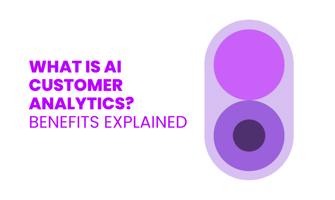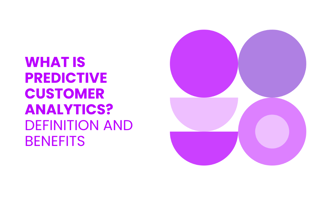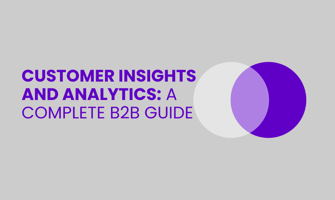How many customers have you lost because you did not have the right information at the right time?...
B2B Customer Analytics: Why It Matters for Business Growth
When you don’t fully understand your business customers, every decision becomes a risk. Many B2B companies struggle because they lack clear insights into customer behavior, leading to poor targeting, slow responses, and lost revenue.
B2B customer analytics gives you the facts you need to work smarter. It helps you see what your customers are doing, what they need, and how to keep them engaged. This article will explain what B2B customer analytics is, why it is important for your business growth, and how you can make it easier with the right solution.
See how Customer Data Analytics makes a difference in "How Customer Data Analytics Improves ROI".
What Is B2B Customer Analytics?
B2B customer analytics means using data to understand how businesses behave as your customers. It looks at things like purchase history, company size, product interest, and how often they interact with your brand. This helps you learn what each business needs and how they make buying decisions.
The goal of B2B customer analytics is to turn raw customer data into useful information. Finding patterns and trends helps you plan better strategies for sales, marketing, and customer service. You learn which accounts are valuable, where risks exist, and what actions will improve your customer relationships.
Why B2B Customer Analytics Matters
B2B companies sell to other businesses, not individuals. This means longer sales cycles, bigger contracts, and more decision makers. If you don’t understand what your customer wants or how they behave, you can lose deals or waste time on low-potential leads. That’s why B2B customer analytics is important. It gives you clear facts so you can target the right accounts and work smarter.
Analytics also helps improve customer retention. By studying behavior patterns, you can spot early signs when a customer is unhappy or likely to leave. This gives you time to respond and fix the issue before losing them. Keeping current customers is easier than getting new ones, so this saves money and protects long-term growth.
Another benefit is better alignment across your teams. Sales, marketing, and customer service all get the same view of each customer. This means less confusion, stronger teamwork, and faster responses. Everyone works toward the same goal using the same data.
Finally, analytics helps you grow revenue. It shows you which customers are ready to buy more, where to cross-sell or upsell, and how to focus on accounts with the highest value. With this insight, you can put resources where they will bring the most return.
Key Components of B2B Customer Analytics
1. Data Collection
Data collection means gathering information about your customers. In B2B, this includes details like purchase history, communication records, website visits, and market data. This step is important because without enough data, you cannot understand customer behavior or needs. Good customer analytics starts with collecting the right data from different sources.
2. Data Integration
Data integration is the process of bringing all your collected data into one place. B2B companies often have data spread across sales, marketing, finance, and customer service systems. If this data stays separate, you miss the full picture. Integration connects these sources, so you can view and use all customer information together.
3. Data Analysis
Data analysis means studying your integrated data to find patterns and trends. In B2B customer analytics, this helps you understand how customers interact with your business, what they need, and when they might buy. Analysis turns raw numbers into useful knowledge that supports better decisions.
4. Actionable Insights
Actionable insights are clear suggestions that come from data analysis. They tell you what steps to take next. In B2B, this could mean knowing which customers to target, when to follow up, or how to improve services. These insights help you move from just understanding data to actually using it to grow your business.
How 180ops Simplifies B2B Customer Analytics for Your Business
1. Turn Disconnected Customer Data into a Single Source of Truth
B2B companies often collect customer data from many places, like sales, marketing, and finance. When this data stays separated, it is hard to see the full picture. This leads to missed patterns in customer behavior and weak decision-making.
Having one clear source of customer data helps you track customer journeys, identify trends, and respond to client needs faster. It allows your teams to work with the same information, reducing confusion and mistakes across departments.
180ops connects your internal customer data with external market information and economic trends. It removes data silos by integrating systems like CRM, financial tools, and customer service platforms. You get a full view of your customers without manual work. With 180ops, you can expect clear insights that improve both strategic planning and daily operations.
2. Anticipate Customer Behavior with AI-Driven Business Forecasts
Knowing what your customers might do next is important in B2B. If you can predict customer behavior, you can plan better and avoid surprises like sudden drops in sales or lost deals. This helps you stay proactive instead of reacting too late.
Accurate forecasts help you manage inventory, align sales targets, and prepare marketing campaigns based on real demand. It also reduces the risk of overcommitting resources where they are not needed.
180ops uses AI and machine learning to study patterns in your customer data. It tracks buying signals, market shifts, and customer engagement to give you forecasts you can trust. You can expect real-time insights that guide your pipeline management and help you stay ahead in your market with fewer risks.
3. Reveal Hidden Opportunities Across Your Customer Portfolio
In B2B, it is easy to miss chances for growth when you do not see the full value of your customer relationships. Many businesses focus only on active deals and overlook customers with untapped potential or upselling and cross-selling opportunities.
Finding these hidden opportunities helps you increase sales by targeting clients who are ready for expansion but have not yet been approached. It also improves customer lifetime value by deepening existing relationships.
180ops analyzes your customer portfolio to highlight where new opportunities exist based on data, not guesses. It identifies accounts with growth signals, such as increased engagement or market readiness. You can expect clear guidance on where to upsell, cross-sell, or re-engage clients, making your sales process more efficient and profitable.
4. Reduce Customer Loss by Detecting Early Signs of Churn
Churn happens when customers stop doing business with you. In B2B, losing a customer can mean a big loss in revenue. Detecting churn early is important because it gives you time to act before it is too late.
If you miss warning signs, you risk losing long-term clients and harming your business growth. Early detection helps you keep valuable customers and reduce the cost of finding new ones.
180ops tracks customer behavior and highlights signs that a customer might leave. It uses AI and data analysis to show you real risks based on real-time data, not guesses. You can expect clear alerts that help you take action quickly. With 180ops, you focus on keeping your customers happy and protecting your revenue.
5. Empower Every Team with Real-Time Customer Insights
B2B companies work better when all teams have access to the same customer information. Sales, marketing, finance, and leadership need real-time insights to stay aligned and make smart decisions.
Without shared data, teams may follow different goals, leading to confusion and missed opportunities. Real-time insights keep everyone on track and improve overall performance.
180ops connects your teams through one platform that delivers live customer data and key performance indicators. You can expect better teamwork, faster responses to customer needs, and smarter strategies. With 180ops, every team knows what is happening with your customers and can act with confidence.
6. Transform Data Overload into Actionable Strategies in Just Weeks
B2B companies collect large amounts of data every day. But too much data without clear direction leads to overload. When you cannot turn data into action, it becomes useless.
It is important to quickly turn raw data into strategies that drive growth and improve decision-making. Waiting months for insights can slow down your business.
180ops is built to deliver value fast. In just a few weeks, it connects your data sources and provides clear, practical recommendations. You can expect to move from complex data to actionable strategies without long setups. With 180ops, you start seeing results quickly and make better decisions to grow your business.
Conclusion
B2B customer analytics turns raw data into useful insights that help you understand your customers better, make smarter decisions, and find new growth opportunities. It allows your teams to stay aligned, reduce customer loss, and focus on the accounts that bring the most value. With the right tools, like 180ops, you can simplify complex data and turn it into actions that drive business success. Using customer analytics is no longer optional if you want to stay competitive. It is the key to improving performance, increasing revenue, and building stronger customer relationships.
180ops is a revenue intelligence platform designed to make B2B customer analytics simple and effective. It uses AI, machine learning, and advanced analytics to turn disconnected customer data into clear, actionable insights. With 180ops, you can predict customer behavior, reduce churn, and uncover hidden growth opportunities without dealing with complex data. If you want to align your teams, boost revenue, and make faster, smarter decisions, 180ops is the solution built for your business needs.
Contact us today to discover how 180ops can simplify B2B customer analytics and drive your business growth.
FAQ
What is B2B customer analytics?
B2B customer analytics is the process of using data to understand how business customers behave and make decisions.
How does B2B customer analytics differ from B2C analytics?
B2B customer analytics focuses on business clients with longer sales cycles and multiple decision makers, while B2C looks at individual consumers.
Why is B2B customer analytics important for businesses?
It helps businesses find the right customers, improve retention, and grow revenue by making smarter, data-driven decisions.
What tools are commonly used for B2B customer analytics?
Companies use tools like CRM systems, data analysis software, and dashboards to collect and study customer data.
How can a company get started with B2B customer analytics?
Start by gathering customer data, combining it in one place, analyzing it, and using the insights to guide business strategies. You can simplify this process and get faster results by using a platform like 180ops.




